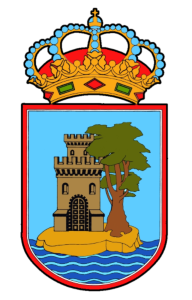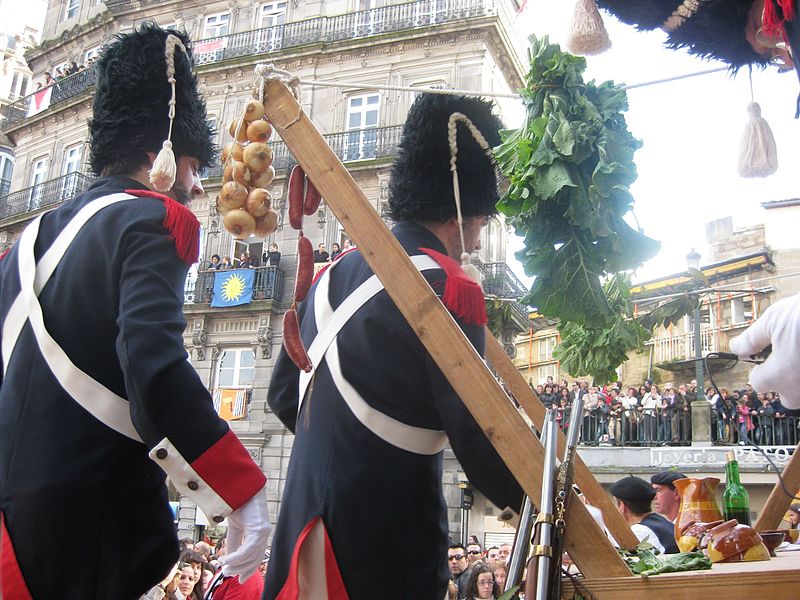Vigo is a city, a port and municipality in the north-west of the Iberian Peninsula, in Galicia, situated on the Ría of the same name on the Atlantic Ocean.
The city of Vigo has 297,124 inhabitants, with an extended metropolitan population of 468,654, making it the 14th-largest metropolitan area of Spain.
The urban area of Vigo is built over both a Pre-Roman hill-fort (O Castro) and a Roman settlement. It is generally accepted that the name Vigo is derived from the Latin word vicus.
Vigo is one of the leading industrial areas in Galicia, with car factories, shipyards, and auxiliary industry. Situated in Vigo is Galicia's leading employer, PSA Peugeot Citroën, which in 2007 produced a total of 545,000 vehicles, of which more than 82% were sold outside Spain.
Vigo has the largest fishing port in Europe as well, the home port of the world's largest fishing company, Pescanova and the most important centre of the Galician canned fish industry. The headquarters of the European Fisheries Agency are placed in here.
The publishing industry, especially in Galician, is very prominent in the city, with Editorial Galaxia and Editorial Xerais among others.
Vigo is also home to the Galician football team which has played longer in the Spanish First Division: Real Club Celta de Vigo (46 seasons in 1st Division, top 11th team in Spain; while RCD A Coruña has played only 41 seasons in 1st division).
The publishing industry, especially in Galician, is very prominent in the city, with Editorial Galaxia and Editorial Xerais among others.
Vigo is also home to the Galician football team which has played longer in the Spanish First Division: Real Club Celta de Vigo (46 seasons in 1st Division, top 11th team in Spain; while RCD A Coruña has played only 41 seasons in 1st division).
During the Middle Ages the small village of Vigo was part of the territory of Portuguese speaking neighbouring towns, particularly Tui, and suffered several Viking attacks. However, the number of inhabitants was so small that, historically, Vigo was not considered to be a real village until around the 15th century, when the earliest records began.
During the 16th and 17th centuries, the city was attacked several times. In 1585 and 1589 the pirate Francis Drake raided the city and temporarily occupied it, leaving many buildings burnt. Several decades later a Turkish fleet tried to attack the city. As a result the walls of the city were built in 1656 during the reign of Philip IV. They are still partially preserved.
During this time, and in spite of the attacks, the city of Vigo developed its earliest commerce, and was given several privileges by the kings of Spain.
In 1702 the Battle of Vigo Bay occurred, and in 1719, because a Spanish fleet which departed from Vigo attempted to invade Scotland in support of the Jacobites, the city was occupied for ten days by a British force.
In 1808 the French Army annexed Spain to the Napoleonic Empire, although Vigo remained unconquered until January, 1809. Vigo was also the first city of Galicia to be freed from French rule in what is now celebrated as the Reconquista (reconquest from French in the context of the Peninsular War) on 28th March each year:
In March 1809, Marshal Soult initiated the second invasion of Portugal through the northern corridor. On 28th March, the Spanish forces defeated the French at Vigo, and the French troops at Marín and Pontevedra were forced to retreat to Santiago de Compostela for fear of being outflanked for the Spanish advance. After of the new turn of the situation, the Spanish forces took the initiative, and most of the cities in the province of Pontevedra were recaptured.
The city grew very rapidly in the 19th and 20th centuries. This resulted in continuous urban planning changes, making Vigo less structured than other Galician towns.
Vigo's climate is usually classified as oceanic; however, the summers tend to be warmer (and drier) and the winters milder than most areas of similar classification. In actuality, with its noticeable drying trend in the summer. Substantial rainfall throughout the year prevents it from being classified as a Mediterranean climate, even though there is a drying trend in summer. The average annual temperature in Vigo is 15 °C. Compared to many other Galician towns, Vigo experiences warmer summer temperatures and milder winters. This is due to its sheltered location, surrounded by mountains inland and the Cíes Islands out in the bay towards the sea.
The University of Vigo is situated in a mountainous area on the outskirts of the city. It is an important centre for studies related to ocean-based industries. The university has other campuses in Pontevedra and Ourense. The campus of Vigo is a modern project of the architect Enric Miralles.
| Nickname(s): The Olive City | |
|
| |
| Coordinates: 42.231356°N 8.712447°W | |
| Country | Galicia |
|---|---|
| Province | Pontevedra |
| County | Vigo |
| Parishes | |
| Government | |
| • Type | Mayor-council |
| • Body | Concello de Vigo |
| Area | |
| • city | 109.1 km2 (42.1 sq mi) |
| Elevation | 0 m (0 ft) |
| Population (2009)INE | |
| • city | 297,332 |
| • Density | 2,700/km2 (7,100/sq mi) |
| • Metro | 468,654 |
| Demonym | vigués (m), viguesa (f) olívico (m), olívica (f) |
| Time zone | CET (UTC+1) |
| • Summer (DST) | CEST (UTC+2) |
| Postcode | 36201-36216 |
| Area code(s) | +34 986 |
| Website | hoxe.vigo.org |
No copyright infringement intended. For educational, non-commercial purposes only.








Congratulations teacher! I don't know if you have written this description of Vigo, but if the answer is "yes" I have to congratulate you because is one of the best descriptions of Vigo i've seen.
ReplyDeleteA student!
Thanks a lot, but no, I haven't written it.
ReplyDelete